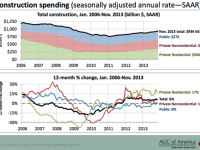Now that the state is moving forward with a targeted crackdown on the practice of worker misclassification, which some in the construction industry have called “a cancer,” lawmakers are going to work through the summer to figure out what more they can do when they reconvene in a regular session in 2015.As you may recall, the Texas Legislature in 2013 passed a bill to root out misclassification on public works projects. While many see that as a step in the right direction, it doesn't go nearly far enough to address the problem. As our readers well know, worker misclassification happens when a company pretends its employees are independent subcontractors when by law the workers qualify as employees and therefore should receive benefits and have their taxes deducted and matched. While there are many legitimate uses for subcontractors, the abuse happens when a company does this with the intent of skirting the law and avoiding payroll taxes.Texas House Speaker Joe Straus, R-San Antonio, has now instructed House members to “examine the issue of misclassifying employees as independent contractors [and the effect this practice has] on workers, employers, income tax withholding, and the unemployment insurance system. Review current statutory deterrents, including those required by HB 2015 (83R), and make recommendations for changes if necessary.”
Reshaping the Construction Industry
Construction employment jumps in January; spending inches up in DecemberEditor’s note: Construction Citizen is proud to partner with AGC America to bring you AGC Chief Economist Ken Simonson's Data DIGest. Check back each week to get Ken's expert analysis of what's happening in our industry.Nonfarm payroll employment increased by 113,000, seasonally adjusted, in December and 2,238,000 (1.7%) over 12 months, the Bureau of Labor Statistics (BLS) reported Friday. (Today’s data included routine once-a-year revisions to monthly data back to January 2009.) Construction employment rose by 48,000 (the largest one-month gain since April 2007) to 5,922,000. Over the past 12 months the industry added 179,000 employees (3.1%). Residential construction employment (residential building and specialty trade contractors) climbed by 16,800 for the month and 121,400 (5.8%) for the year. Nonresidential employment (building, specialty trades, and heavy and civil engineering construction) rose by 31,300 from December and 57,100 (1.6%) year-over-year.
February 10, 2014
Recent reports and studies have found that public education’s focus on 4-year college degrees has led to diminished emphasis on Career and Technical Education (CTE). But with the growing disparity between the skills that industry employers are looking for and the skills which available workers have to offer, that focus is under strong reconsideration.As part of our ongoing efforts to emphasize the importance of CTE as the key to narrowing the skills gap and raise awareness of the well-paying career opportunities in construction, Build Your Future (BYF) and NCCER are joining the Association for Career and Technical Education (ACTE) in celebrating national Career and Technical Education Month all throughout February.
February 07, 2014
When talk of labor shortages has been floated in the past, it has often been customary for those sounding the alarm to be accused of “crying wolf”. But the evidence is rolling in from around the nation – and the world, really – that the problem is as real as it's ever been and it will only intensify if current trends hold. There are some industry leaders, however, who are figuring out ways to combat these workforce issues in ways designed to keep their businesses out of a position like this again in the future.Houston Public Radio recently quoted AGC of America Chief Economist and Construction Citizen Blogger Ken Simonson, who told the station that the oil and gas sector is driving most of Texas’s new construction activity: “The drilling itself counts as mining, but every one of those well sites requires some kind of site preparation, a storage pond, housing for the pumping and processing machinery. We’re also seeing a lot of rail construction to bring natural gas liquids or oil from the fields to the refineries.”That activity in the oil and gas sector sets up a fierce competition for the folks in commercial construction. One of our resident experts, Pat Kiley, has repeatedly pointed out there is a real war for talent in this environment.
February 06, 2014
Editor’s note: AGC Houston held their 2014 Annual Chapter Meeting in January where Ken Simonson offered attendees his update about the improving economy and what that means for construction companies in 2014. In part two of his presentation, he talked about construction spending in various sectors and about construction employment – comparing employment in Texas to that in the rest of the United States.The biggest category in industrial construction spending is the one the census calls power. That includes not just coal, gas, and nuclear-fired power plants, but also those wind projects that have been popping up all over west Texas, solar power, and the transmission lines that you need to carry the power from where it's being generated to where it's being used. It also includes everything that is happening in the oil and gas fields and the pipeline work. It's surprising to see this category down 21%, but that's really kind of a policy-driven fluke.
February 05, 2014
Editor’s note: The following condensed version of Kiley Advisors 2014 Forecast was written by Pat Kiley and Candace Hernandez, co-founders of Kiley Advisors, LLC, and is published here with their permission.Looking BackHouston was a major job creator once more in 2013, adding 86,000 new jobs.Houston again had population growth of approximately 125,000 people.There was positive absorption in all major commercial market segments (office, light industrial, retail and multifamily) again, with the vacancy rate for Class A office space remaining well under 10%. Rental rates continued to increase in all segments as well. Single family new home contracts increased by 20+ percent; spec houses were selling at custom prices.
February 04, 2014
Two-thirds of states post job gains; labor costs rise modestly; steel prices go up for nowEditor’s note: Construction Citizen is proud to partner with AGC America to bring you AGC Chief Economist Ken Simonson's Data DIGest. Check back each week to get Ken's expert analysis of what's happening in our industry.Seasonally adjusted construction employment increased in 34 states between December 2012 and December 2013, decreased in 15 states and the District of Columbia, and remained level in Nebraska, an AGC analysis of Bureau of Labor Statistics (BLS) data released last Tuesday showed. Mississippi led all states with an 18% rise (8,500 jobs), followed by Connecticut (12%, 5,800 jobs), Florida (8.4%, 28,800 jobs) and Wyoming (8.3%, 1,800 jobs). California added the most jobs over the year (28,900, 4.8%), followed by Florida, Texas (13,500, 2.3%), Georgia (9,900, 7.1%) and Mississippi.
February 03, 2014
Several advancements of Construction Career Collaborative were announced at the annual AGC Business meeting on January 23, 2014.First, the Construction Career Collaborative (C3) is moving out of the beta phase which involved three Owners – MD Anderson, Texas Children’s Hospital and the Archdiocese of Galveston-Houston – participating in six beta projects, involving five General Contractors, over 40 specialty contractors and hundreds of craft workers. Owners can now specify the C3 principles on their entire work program or on an individual project basis.Additionally, beginning in February the individual accreditation process of contractors and specialty contractors will begin. Accreditation forms will be available online through a link on the C3 website. There is an annual fee of $1,500 for accredited C3 contractors and specialty contractors. The accreditation process will identify for our Owners the vast number of contractors and specialty contractors that value their craft workers
February 01, 2014
Editor’s note: AGC Houston held their 2014 Annual Chapter Meeting last week where attendees heard about the chapter’s 2013 successes and accomplishments and also received economic and construction industry updates from featured speakers. Ken Simonson, Chief Economist for the Associated General Contractors of America, offered the following update about the improving economy and what that means for construction companies in 2014.Last week, AGC of America put out our annual survey that over 800 companies participated in, and for the first time in the five years that we've done this survey, there was much more optimism about the current year than there was pessimism. We asked first to say when they thought the market would turn positive, and a plurality, 37%, said 2014. Over two-thirds of the firms said it would be this year or next year, and previously a majority had always said that things weren't going to turn up for at least two years. Now here in Houston, the good times have already been rolling, and the breakout on Texas contractors definitely shows more optimism about the current year and about most business segments than the national survey.
January 29, 2014
In Texas political races all over the state, candidates are being grilled about what they think of sweeping education reforms passed by the legislature last year. While there is pretty much universal agreement that the big reductions in standardized testing were a positive step, there is controversy about changes to graduation requirements that create multiple paths to a high school diploma. The idea, essentially, is that not all kids will go to college so the state will now promote both college readiness as well as career readiness.The business community is not monolithic, so there are some such as the Greater Austin Chamber of Commerce and the Texas Association of Business as well as some minority rights groups which want to roll back those reforms.
January 28, 2014



.jpeg?itok=6uFZXEBH)





.jpeg?itok=4Vi_1nJG)






























